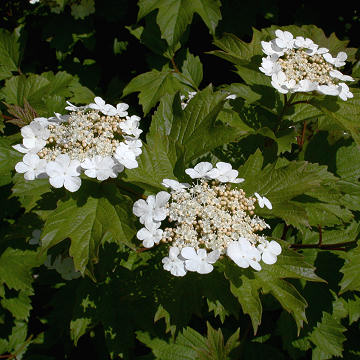

Viburnum trilobum - (image 1 of 6)
Taxonomy
Family: Caprifoliaceae
Habitat
Rich woods.
Associates
Distribution
Newfoundland west to British Columbia, south to PA, northern OH, IA, and WA.
Morphology
Upright shrub to 5 m. Marginal flowers of cyme sterile and greatly enlarged. Leaves 3-lobed with club-like petiolar glands. Fruit red, 10-15 mm with a flat stone.
Notes
Flowers mid to late May
Wetland indicator: Facultative Wetland
Some now regard this as a variety of V. opulus (European Highbush Cranberry). V. trilobum has petiolar glands that are club-like or columnar, not concave, and upper leaf surfaces that are thinly strigose rather than glabrous. It is also ecologically distinct. Perhaps the most telling difference is the fruit, which is tart and reasonably edible in V. trilobum and bitter and completely inedible in V. opulus. The lobes also tend to be more acuminate in V. trilobum.
The pictures of fruit shown here are of V. opulus because I couldn't find a picture of the fruit of V. trilobum. The fruit of the latter would normally be a bit more translucent and not so firm.
Every specimen that I have come across in the wild has had the distally depressed petiolar glands, which leads me to think that our native highbush cranberry is quite rare in the wild relative to the European variety. *I wrote the preceding in 2005 and as of 2009 I have yet to come across V. trilobum in the wild.
References
Dirr, Michael A. 1998. Manual of Woody Landscape Plants: their Identification, Ornamental Characteristics, Culture, Propagation and Uses.
5th ed. Champaign, Illinois: Stipes Publishing L.L.C.
Swink, F. and G. Wilhelm. 1994. Plants of the Chicago Region.
Indiana Academy of Science. The Morton Arboretum. Lisle, Illinois.
|
Michael Hough © 2005 |